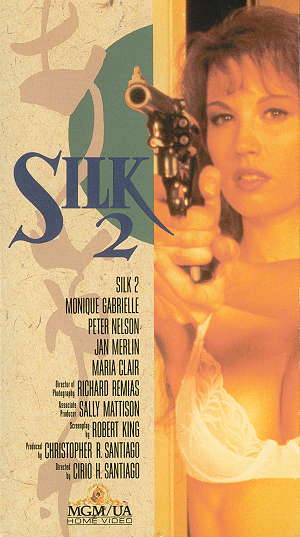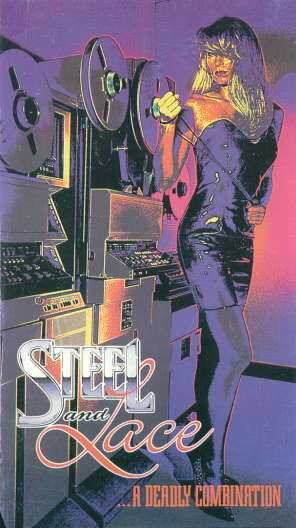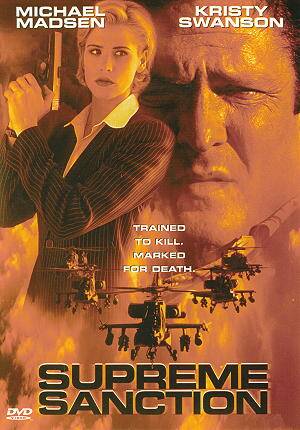★★½
“She’s back! Except, thankfully, she’s not – it’s someone different.”
 Was the world really crying out for a sequel? I guess Silk proved profitable enough for Gabrielle to replace Verrell as the titular cop, three years later and without any explanation. I’ve liked Gabrielle since her barnstorming double role in Deathstalker II, but even I have to admit she’s not really well-cast here, with her voice inappropriate for a supposedly tough crimefighter. Mind you, anyone would have problems with cliched aphorisms of the “Crime doesn’t pay” kind demanded by the dialogue.
Was the world really crying out for a sequel? I guess Silk proved profitable enough for Gabrielle to replace Verrell as the titular cop, three years later and without any explanation. I’ve liked Gabrielle since her barnstorming double role in Deathstalker II, but even I have to admit she’s not really well-cast here, with her voice inappropriate for a supposedly tough crimefighter. Mind you, anyone would have problems with cliched aphorisms of the “Crime doesn’t pay” kind demanded by the dialogue.
After an opening third which is pretty dull and pointless, things do liven up – you get the impression someone actually thought about the script, rather than just spending an hour in Blockbuster, cribbing it off the back of other movies. The goods at the centre of things here are a set of Japanese scrolls which were guarded by a sect of warrior monks; on loan to a “Hawaiian” art-gallery (looks like the Philippines once more), they are switched for a set of fakes. The shenanigans that follow are not perhaps a surprise, yet they are carried out with sufficient energy to keep an uncritical viewer content.
I should point out that, as in the first film, the picture at right does not actually occur anywhere in the movie. Gabrielle does get one surprisingly decent fight sequence however [and I’m not saying that because of her loose-fitting robe, or the wildly gratuitous shower scene which precedes it]. More of such action would have helped – instead, this ends up as a passable, if not exactly memorable, waste of time.
Dir: Cirio Santiago
Star: Monique Gabrielle, Peter Nelson, Jan Merlin, Maria Clair





 Arriving on a DVD of such poor quality, it has been shorn entirely of both opening and closing credits, but hey, I paid $4.99, so can’t really complain. The heroine – named Charlene for most of the film – helps her father run the White Lotus, a rebel group fighting the government in 18th-century China. They have to avoid capture, while simultaneously looking for her long-lost mother (who is in her turn, looking after them), and further diversion is caused by a subplot involving an evil landlord trying to marry a young girl against her will.
Arriving on a DVD of such poor quality, it has been shorn entirely of both opening and closing credits, but hey, I paid $4.99, so can’t really complain. The heroine – named Charlene for most of the film – helps her father run the White Lotus, a rebel group fighting the government in 18th-century China. They have to avoid capture, while simultaneously looking for her long-lost mother (who is in her turn, looking after them), and further diversion is caused by a subplot involving an evil landlord trying to marry a young girl against her will. Inside ten minutes, we’ve had heroine Gaily Morton (Wren) raped and her attackers acquitted in court, not to mention her subsequent leap off a roof-top to her death – this isn’t a film which hangs around, boys and girls. Luckily, her brother is a NASA boffin (Davison – you might recognise him as the Senator from X-Men), who builds a robot in her image, in order to wreak gory revenge on the perpetrators five years later. Cleaning up behind are a cop (Naughton) and his ex-girlfriend, a courtroom artist (Haiduk) who joins the dots.
Inside ten minutes, we’ve had heroine Gaily Morton (Wren) raped and her attackers acquitted in court, not to mention her subsequent leap off a roof-top to her death – this isn’t a film which hangs around, boys and girls. Luckily, her brother is a NASA boffin (Davison – you might recognise him as the Senator from X-Men), who builds a robot in her image, in order to wreak gory revenge on the perpetrators five years later. Cleaning up behind are a cop (Naughton) and his ex-girlfriend, a courtroom artist (Haiduk) who joins the dots. This is an odd little film; heroine Angel (Walden – by some reports now a ski-lift attendant) is an assassin, ordered to take out the leaders of a white slavery ring. After the first killing, she finds solace in the arms of a random guy, and you
This is an odd little film; heroine Angel (Walden – by some reports now a ski-lift attendant) is an assassin, ordered to take out the leaders of a white slavery ring. After the first killing, she finds solace in the arms of a random guy, and you  Director Terlesky starred in one of my favourite guilty pleasures, Deathstalker II, but this shows he still has much to learn about directing and, particularly, scripting. There just isn’t enough going on here to sustain attention, with too many scenes taking twice as long as necessary. Swanson plays Jenna, assassin for a government counter-terrorist agency which is now creating incidents in order to get increased funding. She switches sides and protects TV journalist Jordan McNamara (Dukes), whom she has been ordered to kill – her handler Dalton (Madsen) must now take her out.
Director Terlesky starred in one of my favourite guilty pleasures, Deathstalker II, but this shows he still has much to learn about directing and, particularly, scripting. There just isn’t enough going on here to sustain attention, with too many scenes taking twice as long as necessary. Swanson plays Jenna, assassin for a government counter-terrorist agency which is now creating incidents in order to get increased funding. She switches sides and protects TV journalist Jordan McNamara (Dukes), whom she has been ordered to kill – her handler Dalton (Madsen) must now take her out. The obvious point of comparison for Smith would be Pamela Anderson, another Playboy playmate who moved into films of doubtful quality, but any such comparison would be unfair. To Anderson, that is, who given the right role, is not actually too bad. With Smith, you get the feeling she simply has no talent, and any character would be a stretch, let alone the Shakespeare-aware, ace helicopter pilot and crackshot she is supposed to portray in this shameless Die Hard clone.
The obvious point of comparison for Smith would be Pamela Anderson, another Playboy playmate who moved into films of doubtful quality, but any such comparison would be unfair. To Anderson, that is, who given the right role, is not actually too bad. With Smith, you get the feeling she simply has no talent, and any character would be a stretch, let alone the Shakespeare-aware, ace helicopter pilot and crackshot she is supposed to portray in this shameless Die Hard clone. This one doesn’t really get going until the second half, when the search for a lost hoard of Japanese wartime gold, looted from the Philippines, leads to a remote island. There are CIA agents, revolutionaries, a left-behind Japanese soldier and, of course, our lovely heroines Dona and Taryn (Speir and Carlton) who end up there after their plane crashes in a storm. Or rather, “storm” – you can get a cheap laugh by seeing the bright blue skies as they land in the middle of a clearly hose-supplied downpour. Sidaris probably felt the need to justify their otherwise implausible strip-tease shortly after departure. Or do FAA regulation stipulate pilots must remove their tops in emergencies? Two take-offs for the price of one…
This one doesn’t really get going until the second half, when the search for a lost hoard of Japanese wartime gold, looted from the Philippines, leads to a remote island. There are CIA agents, revolutionaries, a left-behind Japanese soldier and, of course, our lovely heroines Dona and Taryn (Speir and Carlton) who end up there after their plane crashes in a storm. Or rather, “storm” – you can get a cheap laugh by seeing the bright blue skies as they land in the middle of a clearly hose-supplied downpour. Sidaris probably felt the need to justify their otherwise implausible strip-tease shortly after departure. Or do FAA regulation stipulate pilots must remove their tops in emergencies? Two take-offs for the price of one… While this wasn’t Sidaris’s first feature – he’d done The Racing Scene, with James Garner in 1967 – this was likely the prototype of the BB&B (Blood, Bullets & Babes) flicks that would become his trademark. If all the elements do not quite mesh in the way they eventually would, they are all present, mostly in the shape of Anne Randall, a former Playboy playmate who plays private investigator Stacey, and looks a bit like Heather Graham.
While this wasn’t Sidaris’s first feature – he’d done The Racing Scene, with James Garner in 1967 – this was likely the prototype of the BB&B (Blood, Bullets & Babes) flicks that would become his trademark. If all the elements do not quite mesh in the way they eventually would, they are all present, mostly in the shape of Anne Randall, a former Playboy playmate who plays private investigator Stacey, and looks a bit like Heather Graham. Scorpion’s Revenge is an understandable, if not really helpful, retitling of a film called Sasori in USA; as this suggests, it attempts to add an exotic flavour by setting things in an uncivilised and/or dangerous locale. Foreigners are, after all, inherently evil, and do far worse things to our women than we ever would. This isn’t new: many of Roger Corman’s 1970’s WiP movies were shot in the Philippines, albeit partly for cost reasons.
Scorpion’s Revenge is an understandable, if not really helpful, retitling of a film called Sasori in USA; as this suggests, it attempts to add an exotic flavour by setting things in an uncivilised and/or dangerous locale. Foreigners are, after all, inherently evil, and do far worse things to our women than we ever would. This isn’t new: many of Roger Corman’s 1970’s WiP movies were shot in the Philippines, albeit partly for cost reasons.